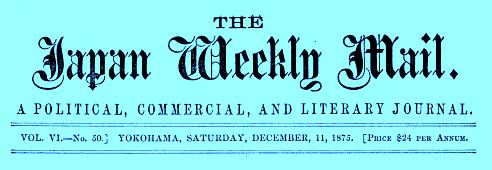|
 |
. . . .
The Bonin Islands.
(Nichi Nichi Shimbun.) The following letter was sent by Amano, one of the party despatched to the Bonin Islands on the 4th instant, from Port Roid to Kishida by the British man-of-war Curlew: — We left Yokohama on the afternoon of the 19th of last month in the Meiji Maru, and after a voyage of moderate weather arrived at the Bonin Islands on the night of the 23rd. As it was dark we did not enter the harbour for fear of the reefs and rocks, but anchored in deep water. Early next morning we entered the harbour of the Father Island, called by foreigners Port Roid. The climate is mild, like our spring. The thermometer stood at about 75°. There are many precipitous cliffs, but no high mountains, and the vegetation is not striking. The largest of the trees is called by the islanders Shi tsu mana, but they do not make lumber, and the wood is unfit for building material. The island is covered with cocoa-nut trees, and in my walks I came upon many lemon-trees bearing friut, which on tasting I found to be very sour. There are also mikan trees, which must have been taken over from Japan. These are the only trees which bear fruit. Vegetables are scarce, though most of the people raise potatoes. Their food principally consists of potatoes, beef, fowls and ducks. The huts in which they dwell are mostly rude and low, roofed with cocoa-nut leaves, the supports consisting of cocoa-nut trees and shi tsu mana wood. These houses resemble the habitations of savages, not only because the materials of which they are made are so inferior, but because there are no carpenters and blacksmiths. There are sixty people on the Islands, consisting of English, Americans, French, Spanish, Oceanic islanders, Negroes, Chinese half-breeds and Japanese, but only two of the latter, both of whom are women and very ignorant though one of them understands a few letters. The islanders are all very indolent, and only raise potatoes or or go out fishing in a strange kind of canoe. Whenever whalers appear, there is a grand rush on board for food and clothing, the latter of which is kept with excessive care. As they have no intercourse with the rest of the world they are indifferent about their appearance, and as they neither buy nor sell they appear not to understand the use of money. They have no care but for their daily food, and this explains their excessive indolence. They seem to resemble the Sennin.* The domestic animals consist of cattle, dogs, cats, fowls, pigs and ducks, but all these differ somewhat from our own. The climate being warm, the grass and trees were still green. The sugar-cane, sweet potatoe, pumpkin and water-melon grow wild. We may infer from this that the soil is rich and productive, but such trees as the pine, cedar and the bamboo are not seen here. Should the kadzuoku, Kaitakushi or some wealthy merchants form a company and colonise these islands, we think that a flourishing colony may soon be added to our country. There is some level ground near the shore, but during violent storms it would be devastated; so that it is comparatively of little use. There are some fields in the valleys, watered by rivulets, and these seem adapted for cultivation. The above is all that I have seen since my arrival. Matzuzaki is daily busy taking photographs, and on my return I will give you more minute particulars. December 3, 1875. * Angels(!) . . . .
|
|
Source.
"The Bonin Islands (Nichi Nichi Shimbun)."
Images may be found at the Internet Archive.
Last updated by Tom Tyler, Denver, CO, USA, Nov 19 2022
|
|